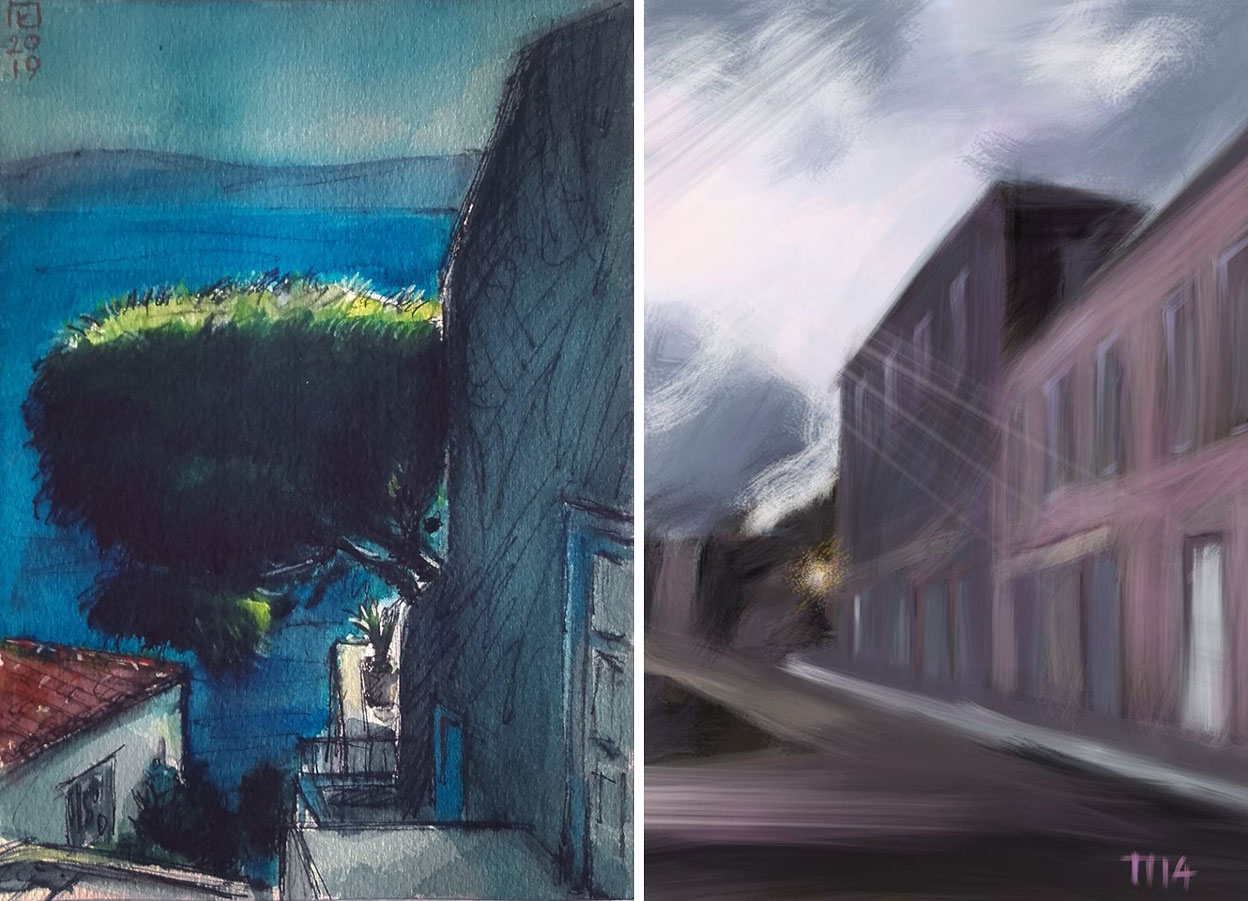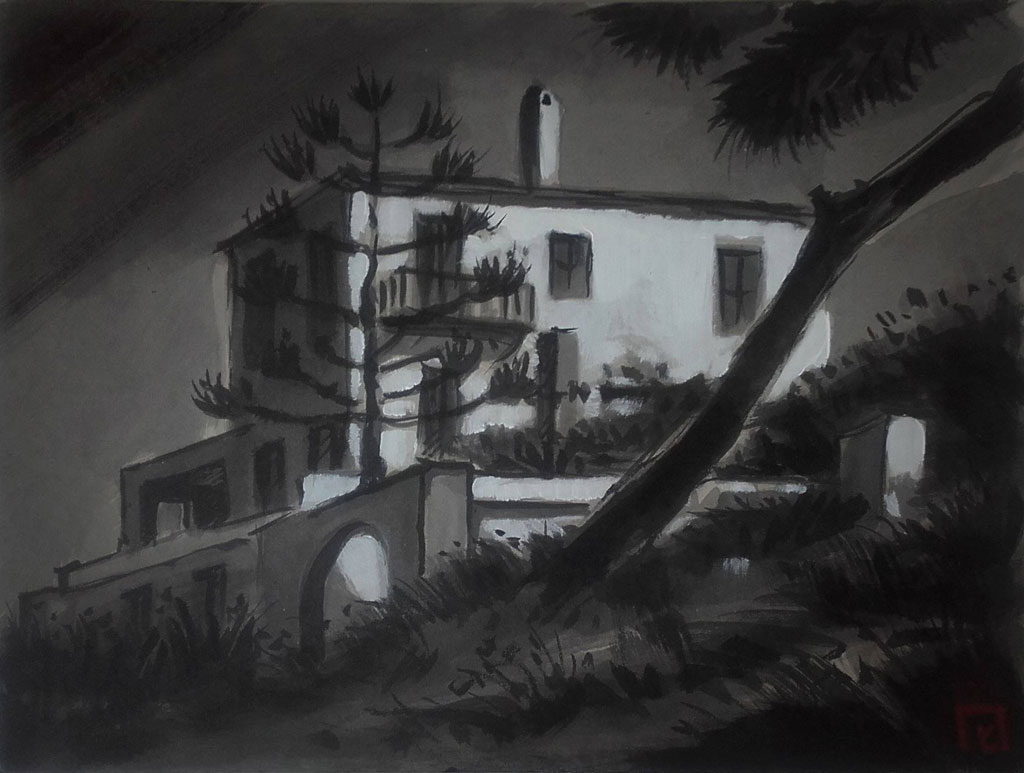INTERVIEW: Panagiotis Rappas
![]() Despite his pivotal position in the international film world, Academy of Motion Pictures Arts and Science voting member, Panagiotis Rappas’ work as a visual artist is little known. Throughout his career he has always continued to draw and paint, even when his work left him little time for this. In 1985 he began working in the animation industry, in Berlin and Munich. In 1989 when Steven Spielberg opened AMBLIN-Universal animation studio in London, he was one of the first-recruited artists. The same time he continues to work as a freelance animation director in various animated projects and television commercials in London’s West End. In 1995 he co-founded Stardust Pictures Ltd and acted as Producer and Creative Director of the projects undertaken by the company such as the acclaimed “1001 Nights” for the Los Angeles Philharmonic and the Oscar nominated animation short “The Periwig Maker”. Between 1998 and 2000 he moved to the United States to provide Storyboard, Layout Supervision and Sequence Direction on various projects for Paramount/Nickelodeon. His animated children films won international recognition and many awards around the globe. Next to his animation work he did Stage Design for many Theatre plays and Illustrations for Children Books. The occasion of his Interview is his first solo exhibition entitled “Time_Memory_Location” where his watercolors present to the viewer his birthplace, Hydra island in Greece.
Despite his pivotal position in the international film world, Academy of Motion Pictures Arts and Science voting member, Panagiotis Rappas’ work as a visual artist is little known. Throughout his career he has always continued to draw and paint, even when his work left him little time for this. In 1985 he began working in the animation industry, in Berlin and Munich. In 1989 when Steven Spielberg opened AMBLIN-Universal animation studio in London, he was one of the first-recruited artists. The same time he continues to work as a freelance animation director in various animated projects and television commercials in London’s West End. In 1995 he co-founded Stardust Pictures Ltd and acted as Producer and Creative Director of the projects undertaken by the company such as the acclaimed “1001 Nights” for the Los Angeles Philharmonic and the Oscar nominated animation short “The Periwig Maker”. Between 1998 and 2000 he moved to the United States to provide Storyboard, Layout Supervision and Sequence Direction on various projects for Paramount/Nickelodeon. His animated children films won international recognition and many awards around the globe. Next to his animation work he did Stage Design for many Theatre plays and Illustrations for Children Books. The occasion of his Interview is his first solo exhibition entitled “Time_Memory_Location” where his watercolors present to the viewer his birthplace, Hydra island in Greece.
By Dimitris Lempesis
Photo: Panagiotis Rappas’ Archive
Mr. Rappas despite the fact that you’ve studied painting and engraving in Germany, you’ve been involved with animation, how did you started your career in the film industry?
I accidentally walked into a small cartoon studio in Berlin in the 80ties, I started experimenting with lines in movement and I probably forgot to get out. I found myself, right after, working on two feature films in Munich. That’s where people from Universal and Spielberg found me in their search for talented artists for Amblin studio they were just about to open in London. I started working on Hollywood productions. I cooperated almost with all the major studios producing Animation films there (Universal, Disney, Warner Bros., Paramount, 20th Century Fox, Columbia, Nickelodeon), something I still do occasionally to this date.
What was it that kept you in animation for so many years?
The art of Animation contains the potential to reach works that in the history of art we define with a German word: Gesamtkunstwerk. That means works of art that contain, combine and condense all arts together. The field of experimentation in it has no boundaries, as well as the ability to evolve its expressive means. The blossoming that experiences Animation in recent years it is not accidental at all.
When did you start to get involved with watercolor?
As a little kid I believe when my dad, who was a sailor, brought me a box of watercolors as a gift. I was painting everywhere with them something that has not changed much until today.
Why watercolor and not painting or engraving? What does it mean for you watercolor?
Being active in the field of Animation, I still change occasionally places of residence and find new things that I want to paint in situ. In the rucksack I carry on my back, there’s always a box of watercolors, a sketchbook, and a small water container. They give me the ability to be ready to paint at any time. I do not need my studio and heavy equipment in that way. It is like the sesame bars and the red wine carried by the Legionnaires of ancient Rome, that gave them the opportunity to walk, even for our time, huge distances with all their weapon equipment, ready for battle and full self-sufficiency… This, of course, does not preclude the possibility of returning to the studio at some point to work with other materials, other techniques, and in larger dimensions.
The series of works that are on presentation in your solo exhibition “Time_ Memory_ Location” at Artshot Gallery, you are focused on Hydra Island, your birthplace. Like Do Ho Suh, who’s his entire work is the places that he has lived, your whole body of work is about the cities and the landscapes that you have lived, why?
The island of Hydra was my first major school. At any level. It hosts almost all my childhood memories. The most important in a man’s life. The first gazes, the first odors, the first flavors, the first loves… But every place one visits and spends part of his life fills a small drawer in memory with knowledge, experiences, joys, and sorrows, pleasant and unpleasant memories that haunt him. These I try to keep with drawings on the spot or to reassemble later in the studio in hope if someone looks at them in the future if they manage to have one, to perceive them as testimonies and to sense what caused them. This process is common I think to most artists and of course to Do Ho Suh from far Korea and his experiences and memories of there.
We notice that your larger watercolors are black and white and the smaller ones and your sketchbooks in color. What means for you the black and white and why do you prefer it in your large sizes instead of color?
The size of a painting is rather a random choice of the moment. But composing a painting looks I think in many aspects, a lot alike with composing in music. Like a piece which was written for orchestra with various instruments synchronized on a rhythm and a given melody full of sound colors tied to each other harmoniously or a piece for an instrument that uses rhythms, melodic scales but a timbre. What matters the most, is if you succeed to capture in it, the music or the painting, as much of what you experienced in life and overwhelmed you. In the hope that they will touch others and open up with them a dialogue in a language that perhaps, does not need the words.
In conclusion I would like to say that I completely disagree with the Impressionists -whom I otherwise admire- in terms of their opinion about black. Black is a color and indeed a color with infinite possibilities, especially when it comes to meet the opposite White. They flirt beautifully and make a good and fruitful couple…










